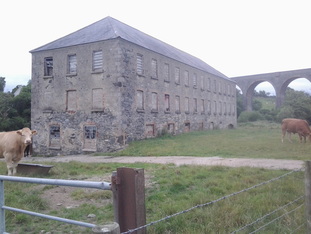What is it all about |
All money donated will go to the upkeep of this site. As little as 10p a month will guarantee that it stays on the web for 10 years.
|
 Beetling Mill at Tassagh with Viaduct behind
Beetling Mill at Tassagh with Viaduct behind
Northern Ireland's milling legacy has largely been ignored and has not shared the benefits that other industries have enjoyed. Linen and Flax the lifeblood of the economy for over 250 years is unknown to children and adults today. Many will not realise that flax is the national flower for Northern Ireland or that it is on our money today. Other milling industries have been long gone for decades.
What is a Mill? Not as simple as it sounds. It involves the use of power from water, wind, engine, muscle or animal power.
The purpose of this site is to make a record of the mills and industry that played a vital role in the history of Ulster and Northern Ireland. Each mill has its own unique features. If walls could speak we would be able to learn a great deal about the construction, mechanics, maintenance and everyday activities that would have went on at these sites. If you have any memories of a mill in your area then add a comment in the Guest Book/Memories page. This will help future generations understand what conditions and life was like back in the day.
Linen, corn, spade, saw, paper, flour and woolen mills (to name but a few) were widespread around Ulster and kept the country in work. Little is being done to protect these heritage sites for the future generations.
It can offer a useful tool for historians, genealogists and people with a general interest in their local area. If you have information about a mill you would like to share or any correction that you spot then please please contact me.
The database will never be complete without local knowledge and input from viewers and so I welcome any information that can fill in the gaps regarding the owner of the mills or when it stopped. The Valuation Records ended in the 1930's and many mills continued right up until the 1960's. Getting a definite closing date will help chart each sites history from start to finish.
What is a Mill? Not as simple as it sounds. It involves the use of power from water, wind, engine, muscle or animal power.
The purpose of this site is to make a record of the mills and industry that played a vital role in the history of Ulster and Northern Ireland. Each mill has its own unique features. If walls could speak we would be able to learn a great deal about the construction, mechanics, maintenance and everyday activities that would have went on at these sites. If you have any memories of a mill in your area then add a comment in the Guest Book/Memories page. This will help future generations understand what conditions and life was like back in the day.
Linen, corn, spade, saw, paper, flour and woolen mills (to name but a few) were widespread around Ulster and kept the country in work. Little is being done to protect these heritage sites for the future generations.
It can offer a useful tool for historians, genealogists and people with a general interest in their local area. If you have information about a mill you would like to share or any correction that you spot then please please contact me.
The database will never be complete without local knowledge and input from viewers and so I welcome any information that can fill in the gaps regarding the owner of the mills or when it stopped. The Valuation Records ended in the 1930's and many mills continued right up until the 1960's. Getting a definite closing date will help chart each sites history from start to finish.
AVAILABLE for tailored mill talks in your area
The Do's and Don't's of surveying
Do Dont
ask permission Arrive early or late in the day to look around
Respect the owners property and time picture any machinery without permission keep an eye on livestock block gates or roads for access ensure site is safe enter a building that is unsafe thank owner before leaving hang about too long
If a site is safe and you have been speaking to the landowner:
Keep an eye out for mill pond's and mill races as they can be heavily overgrown and might be dangerous.
- Machinery - What does the mill contain e.g one pair of millstones (A millstone comes in pairs, top and bottom part). For flax mills, does it have a breaker or rollers? Do they have a maker's mark? Take a picture of the gearing and shafting.
- Water Wheel - Can you identify the water wheel type? Is any writing/stamp's on the iron shrouding? The diameter of the wheel?
- Owners - Ask for information if they have time and note any information as to when the mill stopped or closed.
- Building - Take a picture of the outside and inside and note its condition. How many story's is it? Any strange architecture or date stones. Also check for graffiti at eye level.
- Water - If accessible take a picture of the river and note its name, can the mill race be made out? If so take a picture of that too.
Information and Images can be emailed to [email protected] . This can then be uploaded to the website and you will receive credit for the work done (not monetary as I have spent that on beer). Thanks for your help, it cannot be done alone.